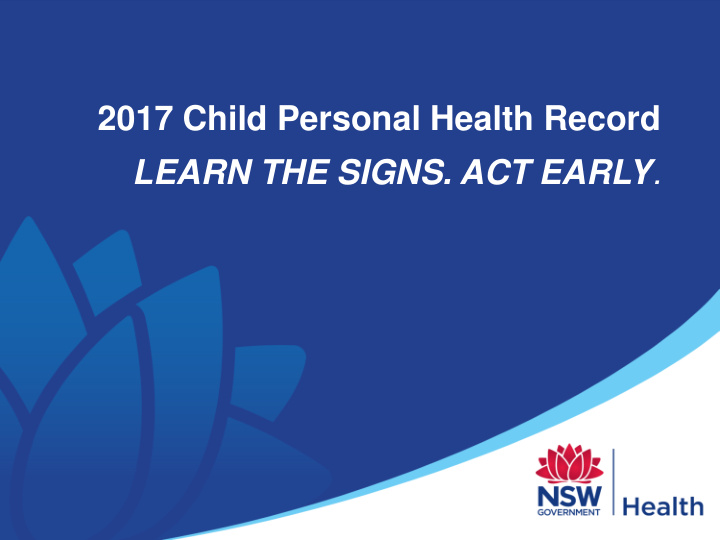



2017 Child Personal Health Record LEARN THE SIGNS. ACT EARLY .
Personal Health Record (Blue Book) NSW Health guidance to parents has changed over time in line with current evidence 1983 edition 2017 edition
2016-2017 Blue Book review Consumer (parents and families) online survey Focus Groups Clinical Reference Groups
Most significant changes to the 2017 edition of Blue Book 1. Physical format of the Blue Book 2. Developmental surveillance
The importance in monitoring brain development Source: The Founders’ Network www.founders.net
Earlier approaches • Screen e.g. Denver • Partnership • Parental Evaluation of Developmental Status (PEDS) • Ages & Stages Questionnaire
Review of development in the Blue Book Process • Clinical Reference Group – undertook a detailed review of all developmental surveillance tools • Recommend a primary assessment tool in the Personal Health Record (PHR) based on current evidence and available information Recommendation Adopt Learn the Signs. Act Early. child developmental monitoring tool
About the Learn the Signs. Act Early. program Centers for Disease Control and Prevention (CDC) : is one of the major operating components of the Department of Health and Human Services in the USA. “ Learn the Signs. Act Early .” : aims to improve early identification of children with autism and other developmental disabilities so children and families can get the services and support they need.
Research underpinning the program https://www.cdc.gov/ncbddd/actearly/about-research.html#topics
Formative Communication Research Parent Results • Lack of knowledge about cognitive, emotional, and social development • Lack of knowledge about developmental delays • Need to communicate urgency of acting early if there is a concern about a developmental delay
Research findings – the evidence Health Care Professional (HCP) results : • Limited acknowledgement of key childhood developmental milestones and the importance of early intervention among peers • Most frequently mentioned issue about childhood development: resources and services Other issues included: • a poor understanding by parents of the importance of early intervention • reliance on parents to bring up developmental issues
Objectives of Learn the Signs. Act Early. • Increase AWARENESS of developmental milestones and early warning signs • Increase KNOWLEDGE in the benefits of early action and service system • Increase parent-provider DIALOGUE on the topic of developmental milestones and disorders • Increase EARLY ACTION on childhood developmental disorders
Benefits of Learn the Signs. Act Early. • Easily accessible information that can be downloaded and/or printed • Provides milestones checklists as anticipatory guidance to facilitate developmental • Surveillance discussion • Broader range of partners (early childhood educators, general practitioners, practice nurses and Family and Community Services. • Enhances parents' developmental knowledge and health literacy.
Learn the Signs. Act Early. milestone checklist
Model Referral Pathway
Local Health District Referral Pathway • Local Health District to insert their model pathway
Developmental screening tool • Ages & Stages Questionnaire for developmental and social-emotional screening
Resources for parents
Resources to promote Learn the Signs. Act Early.
Learn the Signs. Act Early. Online training module Watch Me! 1 hour, 4-module course
Resources and contact details • Child and Family Health Nursing Services www.health.nsw.gov.au/child-family-health-services • Blue Book www.health.nsw.gov.au/mybluebook • Love Talk Sing Read Play http://ltsrp.resourcingparents.nsw.gov.au/ • Raising Children http://raisingchildren.net.au/ • CDC Learn the Signs. Act Early. https://www.cdc.gov/ Search for Learn the Signs. Act Early. Contact April Deering adeer@doh.health.nsw.gov.au
Recommend
More recommend